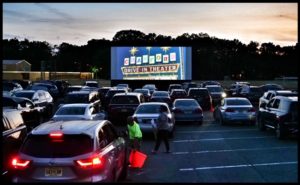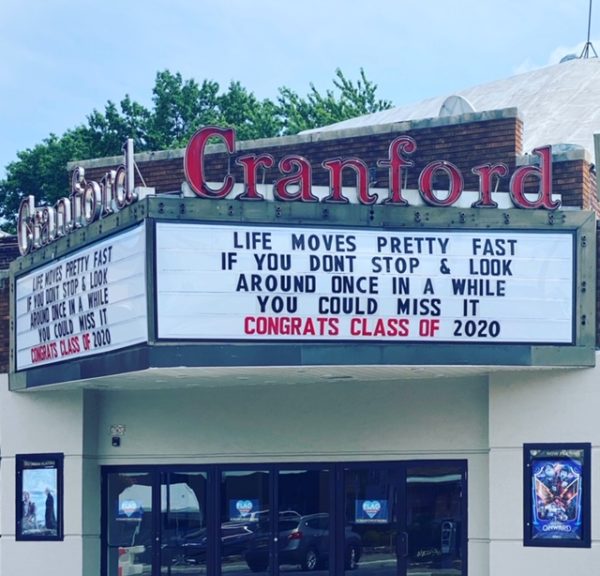Like many exhibitors in the age of COVID-19, Cranford Theater owner Doreen Sayegh is leaning into the drive-in model, giving many customers their first taste of the resurgent moviegoing format. As it turns out, it’s new for her too.
“I have to be honest, [I’d] never been to a drive-in,” says Sayegh, who in June opened a “pop-up” location in the parking lot of a swimming pool located just a short drive away from her five-screen theater in Cranford, New Jersey. “Once the movie starts, I park my car in the back.”
Sayegh is far from the only U.S. theater owner who has opened a so-called pop-up drive-in since the coronavirus forced a shutdown of hard top theaters beginning in mid-March, but her approach has been more creative than most. At the Cranford drive-in, screenings of old classics come with a variety of bells and whistles, from costumed employees to tailor-made pre-show PSAs to themed souvenirs. Guests who arrived as a recent screening of the original Superman received a custom dog tag; for a “Christmas in July” screening of Elf, moviegoers were checked in by men dressed as Santa Claus and Buddy; and to secure entry to an August 5 screening of the 1971 classic Willy Wonka and the Chocolate Factory, potential customers must track down one of 65 tickets by shopping at local businesses.
Sayegh is driven by a sense of purpose that goes beyond just keeping the Cranford afloat during the crisis. “I wanted to do something that would make people happy,” she says. “Movies have always been an escape from reality.”

The theater has also baked in a charitable component to every screening. In addition to an ongoing canned food drive for the local homeless shelter, the Cranford has partnered with non-profit organizations including the Christopher and Dana Reeve Foundation, which solicited donations from customers at the Superman screening and even brought in a speaker to raise awareness about spinal cord injuries, which Christopher Reeve suffered during a 1995 horseback riding accident. (The theater has also agreed to match every donation that comes in and is hosting a virtual donation box for the foundation on the drive-in’s concessions page.) Going forward, Sayegh is also looking to donate a portion of ticket proceeds to various organizations, including those for frontline workers. She additionally used a recent screening of Ferris Bueller’s Day Off to kick off a drive for school and cleaning supplies for disadvantaged local children and teachers.
These activations are Sayegh’s way of adding depth to the drive-in experience, which prior to the pandemic had been whittled down to just over 300 drive-in theaters across the U.S. – down from a high of around 4,000 in the late ‘50s and early ‘60s. So far, the experiment has been a rousing success; with a capacity of roughly 60 cars, the drive-in’s first week of screenings sold out in less than three minutes. In the second week, she says, two showings of The Goonies sold out in just a minute and a half.
“When we looked at the analytics…in the queue, [there] were hundreds of people five minutes before tickets went on sale,” says Sayegh, who created the theater’s website using the web development and analytics platform Cinema Hosting. “They were waiting.”
Sayegh has a lifelong history in the exhibition business. When she was a child, her father owned a chain of movie theaters in New Jersey that included the Cranford. “I always worked for him,” she says. After the chain’s business operations (though not the properties themselves) were sold in 2010 to DigiPlex Destinations – later acquired by Carmike – Sayegh remained on board, only opting to leave after AMC’s subsequent acquisition of Carmike would have required her to relocate. She went on to consult for ScreenVision for a time and was on the cusp of switching careers altogether when fate intervened.
“I was actually just about to go into a whole different industry [when] the company that was operating our theaters in Cranford and Westfield abandoned both buildings at the end of the summer last year,” says Sayegh. Noting that the previous tenants had left the Cranford in “really bad shape,” she spied an opportunity to return the 100-year-old theater to its former glory. Thus began a process of renovating the Cranford and bringing it up to code before reopening it on November 8, 2019.
By Sayegh’s account, business was brisk at the Cranford for the first four months – and then came the coronavirus. “By the first week of March, my staff was already in gloves and masks, and the numbers had declined terribly,” she says. Two days before the government mandated it, Sayegh shut the theater down. “People were scared and, you know, I didn’t want my staff getting infected,” she says. “It wasn’t socially responsible to stay open.”
A hardened survivor in an industry that has faced constant threats to its model over the last several decades, Sayegh jumped into action almost immediately, selling concessions, gift certificates and t-shirts and creating gift packs, including discounted movie tickets, to encourage customers to return to the theater once it reopened its doors. By the end of April, she caught wind of the phenomenon of pop-up drive-ins – some of which, she found, were established by people outside the exhibition business.
“I said to myself, I’m going to really kick myself if I don’t do this, because I’m in the business,” she says. “If anybody should do it, it should be one of us.”
What followed was a nearly two-month period that saw Sayegh researching, planning and, finally, putting together a proposal for the Cranford mayor and city council. Once approved, plans for the Cranford drive-in were published in the township newsletter and ultimately made their way onto social media and local news outlets. Sayegh’s own Facebook and Instagram posts on the project were collectively shared over 2,000 times, increasing the theater’s social media footprint and more than tripling the circulation of its newsletter.
Though set-up costs for the Cranford drive-in “were up there” (the theater erected a high-quality 40-foot screen and also built a projection/concessions booth out of an oversized shipping container), Sayegh is quick to note that the investment has been worth it. Sellouts have continued for forthcoming screenings of films including The Karate Kid, Uncle Buck and Beetlejuice, and some customers have even begun to ask if the theater is planning to continue with the concept next summer (it’s currently slated to run through Labor Day and potentially into October). With no end to the pandemic in sight and indoor theaters in New Jersey ordered to remain closed for the foreseeable future – a policy that is now the subject of a lawsuit filed by six theater chains and NATO against New Jersey governor Phil Murphy – Sayegh certainly isn’t ruling it out. Whatever the future looks like, she’s determined to keep the Cranford – not to mention the business that has shaped the trajectory of her life and career – alive.
“I’d say there’s definitely some concern,” says Sayegh when asked if she’s worried about the viability of her industry during the pandemic. “But I’m definitely not going down without a fight.”



Share this post